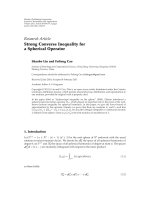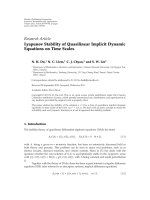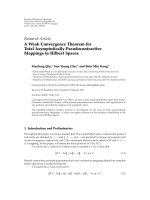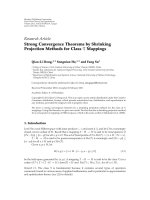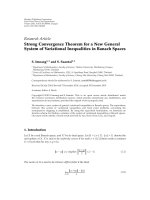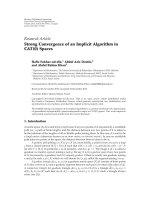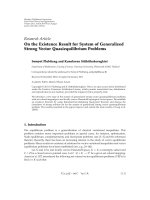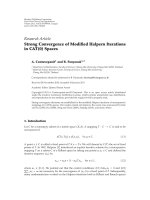Báo cáo hóa học: " Research Article Strong Stability and Asymptotical Almost Periodicity of Volterra Equations in Banach Spaces" potx
Bạn đang xem bản rút gọn của tài liệu. Xem và tải ngay bản đầy đủ của tài liệu tại đây (500.58 KB, 12 trang )
Hindawi Publishing Corporation
Advances in Difference Equations
Volume 2011, Article ID 414906, 12 pages
doi:10.1155/2011/414906
Research Article
Strong Stability and Asymptotical Almost
Periodicity of Volterra Equations in Banach Spaces
Jian-Hua Chen
1
and Ti-Jun Xiao
2
1
School of Mathematical and Computational Science, Hunan University of Science and Technology,
Xiangtan, Hunan 411201, China
2
School of Mathematical Sciences, Fudan University, Shanghai 200433, China
Correspondence should be addressed to Ti-Jun Xiao,
Received 1 January 2011; Accepted 1 March 2011
Academic Editor: Toka Diagana
Copyright q 2011 J H. Chen and T J. Xiao. This is an open access article distributed under
the Creative Commons Attribution License, which permits unrestricted use, distribution, and
reproduction in any medium, provided the original work is properly cited.
We study strong stability and asymptotical almost periodicity of solutions to abstract Volterra
equations in Banach spaces. Relevant criteria are established, and examples are given to illustrate
our results.
1. Introduction
Owing to the memory behavior cf., e.g., 1, 2 of materials, many practical problems in
engineering related to viscoelasticity or thermoviscoelasticity can be reduced to the following
Volterra equation:
u
t
Au
t
t
0
a
t − s
Au
s
ds, t ≥ 0,
u
0
x
1.1
in a Banach space X,withA being the infinitesimal generator of a C
0
-semigroup Tt defined
on X,anda· ∈ L
p
R
, C a scalar function R
:0, ∞ and 1 ≤ p<∞, which is often
called kernel function or memory kernel cf., e.g., 1. It is known that the above equation is
well-posed. This implies the existence of t he resolvent operator St, and the mild solution is
then given by
u
t
S
t
x, t ≥ 0, 1.2
2 Advances in Difference Equations
which is actually a classical solution if x ∈ DA. In the present paper, we investigate strong
stability and asymptotical almost periodicity of the solutions. For more information and
related topics about the two concepts, we refer to the monographs 3, 4. In particular, their
connections with the vector-valued Laplace transform and theorems of Widder type can be
found in 4–6. Recall the following.
Definition 1.1. Let X be a Banach space and f : R
→ X a bounded uniformly continuous
function.
i f is called almost periodic if it can be uniformly approximated by linear combinations
of e
ibt
x b ∈ R,x∈ X. Denote by APR
,X the space of all almost periodic
functions on R
.
ii f is called asymptotically almost periodic if f f
1
f
2
with lim
t →∞
f
1
t0andf
2
∈
APR
,X. Denote by AP PR
,X the space of all asymptotically almost periodic
functions on R
.
iii We call 1.1 or St strongly stable if, for each x ∈ DA, lim
t →∞
Stx 0. We
call 1.1 or St asymptotically almost periodic if for each x ∈ DA,S·x ∈
APPR
,X.
The following two results on C
0
-semigroup will be used in our investigation, among
which the first is due to Ingham see, e.g., 7,Section1 and the second is known as Countable
Spectrum Theorem 3, Theorem 5.5.6. As usual, the letter i denotes the imaginary unit and iR
the imaginary axis.
Lemma 1.2. Suppose that A generates a bounded C
0
-semigroup Tt on a Banach space X.IfσA ∩
iR ∅,then
T
t
A
−1
−→ 0,t−→ 0. 1.3
Lemma 1.3. Let Tt be a bounded C
0
-semigroup on a reflexive Banach space X with generator A.If
σA ∩ iR is countable, then Tt is asymptotically almost periodic.
2. Results and Proofs
Asymptotic behaviors of solutions to the special case of at ≡ 0 have been studied
systematically, see, for example, 3, Chapter 4 and 8, Chapter V. T he following example
shows that asymptotic behaviors of solutions to 1.1 are more complicated even in the finite-
dimensional case.
Example 2.1. Let X C,A −2I, at−e
−t
in 1.1. Then taking Laplace transform we can
calculate
u
t
1
3
1 2e
−3t
x.
2.1
Advances in Difference Equations 3
It is clear that the following assertions hold.
a The corresponding semigroup Tte
−2t
is exponentially stable.
b Each solution with initial value x ∈ DA,x
/
0isnot strongly stable and hence not
exponentially stable.
c Each solution with x ∈ DA is asymptotically almost periodic.
It is well known that the semigroup approach is useful in the study of 1.1.More
information can be found in the book 8, Chapter VI.7 or the papers 9–11.
Let X : X × L
p
R
,X be the product Banach space with the norm
x
f
2
:
x
2
f
2
L
p
R
,X
2.2
for each x ∈ X and f ∈ L
p
R
,X. Then the operator matrix
A :
⎛
⎜
⎝
Aδ
0
B
d
ds
⎞
⎟
⎠
,D
A
: D
A
× W
1,p
R
,X
2.3
generates a C
0
-semigroup on X. Here, W
1,p
R
,X is the vector-valued Sobolev space and δ
0
the Dirac distribution, that is, δ
0
ff0 for each f ∈ W
1,p
R
,X; the operator B is given
by
Bx : a
·
Ax for each x ∈ D
A
. 2.4
Denote by St the C
0
-semigroup generated by A. It follows that, for each x ∈ DA,thefirst
coordinate of
u
t
F
t, ·
: S
t
x
0
2.5
is the unique solution of 1.1.
Theorem 2.2. Let A be the generator of a C
0
-semigroup Tt on the Banach space X and a· ∈
L
p
R
, C with 1 ≤ p<∞. Assume that
i M is a left-shift invariant closed subspace of L
p
R
,X such that a·Ax ∈ M for all
x ∈ DA;
ii C
⊂ ρA|
D
and
R
λ, A|
D
≤
K
|
λ
|
,λ∈ C
2.6
4 Advances in Difference Equations
for some constant K>0. Here, D : DA ×{f ∈ W
1,p
R
,X ∩ M : f
∈ M} :
DA × M
1
.
Then
a1.1 is strongly stable if iR ⊂ ρA|
D
;
b if X is reflexive and 1 <p<∞, then every solution to 1.1 is asymptotically almost
periodic provided σA|
D
∩ iR is countable.
Proof. Since the first coordinate of 2.5 is the unique solution of 1.1, it is easy to see that the
strong stability and asymptotic almost periodicity of 1.1 follows from the strong stability
and asymptotic almost periodicity of St, respectively.
Moreover, from 9, Proposition 2.8 we know that if M is a closed subspace of
L
p
R
,X such that M is S
l
t-invariant and a·Ax ∈ M for all x ∈ DA, then A|
D
the
restriction of A to D generates the C
0
-semigroup
S
t
: S
t
|
M
,
2.7
which is defined on the Banach space
M : X × M. 2.8
Thus, by assumptions i, ii and the well-known Hille-Yosida theorem for C
0
-semigroups,
we know that
St is bounded. Hence, in view of Lemma 1.2,weget
S
t
A|
−1
D
−→ 0,t−→ ∞ . 2.9
Clearly
A|
−1
D
Ax
a
·
Ax
x
0
2.10
for each x ∈ DA. So, combining 2.5 with 2.9, we have
u
t
2
≤
u
t
F
t, ·
2
S
t
x
0
2
S
t
A|
−1
D
Ax
a
·
Ax
2
≤
S
t
A|
−1
D
2
·
1
a
·
2
L
p
·
Ax
2
−→ 0,t−→ ∞ .
2.11
This means that a holds.
Advances in Difference Equations 5
On the other hand, we note that, to get b,itissufficient to show that
St is
asymptotically almost periodic. Actually, if X is reflexive and 1 <p<∞, then it is not hard
to verify that L
p
R
,X is reflexive. Hence, X × L
p
R
,X is reflexive. By assumption i, M
is a closed subspace of X × L
p
R
,X. Thus, Pettis’s theorem shows that M is also reflexive.
Hence, in view of Lemma 1.3,wegetb. This completes the proof.
Corollary 2.3. Let A be the generator of a C
0
-semigroup Tt on the Banach space X and at
αe
−βt
β>0,α
/
0. Assume that
i for each λ ∈ C
,λ,λλ β/λ α β ∈ ρA,
ii there exists a constant C>0 satisfying
H
λ
2
|
α
|
2
β ·
λ α β
2
·
I − λHλ
2
≤
C
|
λ
|
2
,λ∈ C
2.12
with
H
λ
:
λ β
λ α β
λ
λ β
λ α β
− A
−1
.
2.13
Then
a if Reα β
/
0 and
λ
−1 iβ
α β iλ
∈ ρ
A
2.14
for each λ ∈ R,then1.1 is strongly stable;
b if X is reflexive and 1 <p<∞,then1.1 is asymptotically almost periodic provided
λ ∈ R : iλ
iλ β
iλ α β
−1
∈ σ
A
2.15
is countable.
Proof. As in 9,Section3, we take
M :
e
−βs
x : x ∈ X
⊂ L
p
R
,X
. 2.16
In view of the discussion in 8, Lemma VI.7.23, we can infer that
C
⊂ ρ
A|
D
, if C
⊂ ρ
A
,
λ
λ β
λ α β
∈ ρ
A
, for each λ ∈ C
.
2.17
6 Advances in Difference Equations
Moreover, we have
R
λ, A
⎛
⎜
⎝
I − a
λ
R
λ, A
A
−1
0
R
λ,
d
ds
B
I − a
λ
R
λ, A
A
−1
I
⎞
⎟
⎠
⎛
⎜
⎜
⎜
⎝
R
λ, A
R
λ, A
δ
0
R
λ,
d
ds
0 R
λ,
d
ds
⎞
⎟
⎟
⎟
⎠
⎛
⎜
⎜
⎜
⎝
H
λ
H
λ
δ
0
R
λ,
d
ds
R
λ,
d
ds
BH
λ
R
λ,
d
ds
BH
λ
δ
0
R
λ,
d
ds
R
λ,
d
ds
⎞
⎟
⎟
⎟
⎠
.
2.18
Hence,
R
λ, A|
D
2
≤
H
λ
2
|
α
|
2
β ·
λ α β
2
·
I − λHλ
2
×
2β
λ β
2
1
1
λ β
2
2.19
with Hλ being defined as in 2.13. Thus, it is clear that
St is bounded if 2.12 is satisfied.
Next, for λ ∈ R, we consider the eigenequation
iλ −A|
D
x
f
y
g
. 2.20
Writing f e
−βs
f
0
and g e
−βs
g
0
, we see easily that 2.20 is equivalent to
iλ − A
x − f
0
y,
−αAx
iλ β
f
0
g
0
.
2.21
Thus, if Reα β
/
0and
λ
−1 iβ
α β iλ
∈ ρ
A
,
2.22
Advances in Difference Equations 7
then by 2.21 we obtain
x
α β iλ
−1
λ
−1 iβ
α β iλ
− A
−1
iλ β
y g
0
,
f
0
α β iλ
−1
iλ − A
λ
−1 iβ
α β iλ
− A
−1
iλ β
y g
0
− y.
2.23
By the closed graph theorem, the operator
iλ − A
λ
−1 iβ
α β iλ
− A
−1
2.24
in the second equality of 2.23 is bounded. Hence, noting that
iλ β
y g
0
2
≤ 2
iλ β
y
2
g
0
2
2
iλ β
2
·
y
2
2β
g
2
,
2.25
we have
iλ ∈ ρ
A|
D
for each λ ∈ R. 2.26
Consequently, in view of a of Theorem 2.2, we know that 1.1 is strongly stable if 2.14
holds.
Furthermore, by 9, Lemma 3.3, we have
σ
A|
D
⊂
λ ∈ C : λ
λ β
λ α β
−1
∈ σ
A
∪
−
α β
. 2.27
Combining this with b of Theorem 2.2, we conclude that 1.1 is asymptotically almost
periodic if X is reflexive, 1 <p<∞, and the set in 2.15 is countable.
Theorem 2.4. Let A be the generator of a C
0
-semigroup Tt on the Banach space X and a· ∈
L
p
R
, C with 1 ≤ p<∞. Assume that
i for all λ ∈ C
,
a
λ
/
− 1,λ
1 a
λ
−1
∈ ρ
A
,
sup
λ>0,n0,1,2,
λ
n1
λH
λ
− 1
n
λ
n!
< ∞,
2.28
λHλ, λ
2
H
λ is bounded on C
,whereHλ :λ − 1 aλA
−1
,
8 Advances in Difference Equations
ii qλ is analytic on C
and λqλ, λ
2
q
λ are bounded on C
,where
q
λ
:
H
λ
λ − α − iη
,
2.29
for each iη ∈ iE iE is the set of half-line spectrum of Hλ and α>0,
iii for each x ∈ X and iη ∈ iE, the limit
lim
α → 0
αe
αiηt
H
α iη
x
2.30
exists uniformly for t ≥ 0.
Then every solution to 1.1 is asymptotically almost periodic. Moreover, if for each x ∈ X and
iη ∈ iE the limit in 2.30 equals 0 uniformly for t ≥ 0,then1.1 is strongly stable.
Proof. Take x ∈ DA. Then the solution Stx to 1.1 is Lipschitz continuous and hence
uniformly continuous. Actually, by assumption i, we know that
∞
0
e
−λt
S
t
xdt
λ −
1 a
λ
A
−1
x, Re λ>0,
2.31
and that
r
λ
:
λH
λ
− 1
x 2.32
is analytic on C
.Thus,r ∈ C
∞
0, ∞,X and
H
λ
x −
1
λ
x
r
λ
λ
∞
0
e
−λt
S
t
x − x
dt, λ > 0.
2.33
On the other hand, if 2.28 holds, then there exists K>0 such that
sup
λ>0
λ
n1
r
n
λ
n!
≤ sup
λ>0
λ
n1
λH
λ
− 1
n
λ
n!
x
≤ K
x
,n 0, 1, 2,
2.34
Hence, from 4, Chapter 1or 5 and the uniqueness of the Laplace transform, it follows
that
F
t
: S
t
x − x 2.35
satisfies
r
λ
λ
∞
0
e
−λt
F
t
dt, λ > 0,
2.36
Advances in Difference Equations 9
and that
F
t h
− F
t
S
t h
x − S
t
x
≤ Kh
x
,t≥ 0,h≥ 0. 2.37
Moreover, by 3, Corollary 2.5.2, the assumption i implies the boundedness of St.
Therefore,
f
t
: S
t
x 2.38
is bounded and uniformly continuous on 0, ∞. In addition, the half-line spectrum set of ft
is just the following set:
iη ∈ iR : H
λ
cannot be analytically extened to an eighborhood of iη
. 2.39
Write τ α iη. Then
∞
0
e
−τs
f
t s
ds e
τt
∞
t
e
−τs
f
s
ds
e
τt
f
τ
−
t
0
e
−τs
f
s
ds
e
τt
H
τ
x −
e
τ·
∗ f
t
,
2.40
q
λ
H
λ
x
λ − α − iη
e
τ·
∗ f
λ
. 2.41
From assumption ii and 3, Corollary 2.5.2, it follows that e
τ·
∗ ft is bounded, which
implies
lim
α → 0
α
e
τ·
∗ f
t
0
2.42
uniformly for t ≥ 0. Finally, combining 2.40 with Theorem 7, Theorem 4.1, we complete
the proof.
3. Applications
In this section, we give some examples to illustrate our results.
First, we apply Corollary 2.3 to Example 2.1. As one will see, the previous result will
be obtained by a different point of view.
Example 3.1. We reconsider Example 2.1.First,wenotethat
α β 0. 3.1
10 Advances in Difference Equations
This implies that condition Reα β
/
0 is not satisfied. Therefore, part a of Corollary 2.3
is not applicable, and this explains partially why the corresponding Volterra equation is not
strongly stable. However, it is easy to check that conditions i and ii in Corollary 2.3 are
satisfied. In particular, we have accordingly
H
λ
λ 1
λ
λ 3
,
3.2
and hence the estimate
Hλ
2
|
α
|
2
β ·
λ α β
2
·
I − λHλ
2
|
λ 1
|
2
4
|
λ
λ 3
|
2
≤
13/9
|
λ
|
2
,λ∈ C
.
3.3
Note σA{−2} and
λ ∈ R : iλ
iλ β
iλ α β
−1
∈ σ
A
{
λ ∈ R : iλ 1 −2
}
∅. 3.4
Applying part b of Corollary 2.3, we know that the corresponding Volterra equation is
asymptotically almost periodic.
Example 3.2. Consider the Volterra equation
∂u
∂t
t, x
∂
2
u
∂x
2
t, x
α
t
0
e
−βt−s
∂
2
u
∂x
2
s, x
ds, t > 0, 0 ≤ x ≤ π,
u
0,t
u
π, t
0,t≥ 0,
u
0,x
u
0
x
, 0 ≤ x ≤ π,
3.5
where the constants satisfy
β>0,α β 0. 3.6
Let H L
2
0,π,anddefine
A :
d
2
dx
2
,D
A
f ∈ H
2
0,π
: f
0
f
π
0
.
3.7
Then 3.5 can be formulated into the abstract form 1.1. It is well known that A is self-adjoint
see, e.g., 12, page 280, b of Example 3 and that A generates an analytic C
0
-semigroup.
The self-adjointness of A implies
λ − A
−1
1
dist
λ, σ
A
,λ∈ ρ
A
.
3.8
Advances in Difference Equations 11
On the other hand, we can compute
σ
A
σ
p
A
−n
2
: n 1, 2,
. 3.9
It follows immediately that condition i in Corollary 2.3 holds. Moreover, corresponding to
2.13, we have
H
λ
λ β
λ
λ β − A
−1
.
3.10
Combining this with 3.6, 3.8,and3.9, we estimate
Hλ
2
|
α
|
2
β ·
λ α β
2
·
I − λH
λ
2
1
|
λ
|
2
λ β
2
·
λ β − A
−1
2
β
I −
λ β
λ β − A
−1
2
≤
1
|
λ
|
2
λ β
2
λ β 1
2
β
1
λ β
2
λ β 1
2
≤
1 2β
|
λ
|
2
,λ∈ C
.
3.11
Note that 2.15 becomes
λ ∈ R : iλ β −n
2
for some n ∈ N
∅. 3.12
Applying part b of Corollary 2.3,by3.11, we conclude that 3.5 is asymptotically almost
periodic cf. 9, Remark 3.6.
Acknowledgments
This work was supported partially by the NSF of China 11071042 and the Research Fund
for Shanghai Key Laboratory for Contemporary Applied Mathematics 08DZ2271900.
References
1 M. Conti, S. Gatti, and V. Pata, “Uniform decay properties of linear Volterra integro-differential
equations,” Mathematical Models & Methods in Applied Sciences, vol. 18, no. 1, pp. 21–45, 2008.
2 L. Pandolfi, “Riesz systems and controllability of heat equations with memory,” Integral Equations and
Operator Theory, vol. 64, no. 3, pp. 429–453, 2009.
3 W. Arendt, C. J. K. Batty, M. Hieber, and F. Neubrander, Vector-Valued Laplace Transforms and Cauchy
Problems, vol. 96 of Monographs in Mathematics,Birkh
¨
auser, Basel, Switzerland, 2001.
4 T J. Xiao and J. Liang, The Cauchy Problem for Higher-Order Abstract Differential Equations, vol. 1701 of
Lecture Notes in Mathematics, Springer, Berlin, Germany, 1998.
12 Advances in Difference Equations
5 T. Xiao and J. Liang, “Laplace transforms and integrated, regularized semigroups in locally convex
spaces,” Journal of Functional Analysis, vol. 148, no. 2, pp. 448–479, 1997.
6 T J. Xiao and J. Liang, “Approximations of Laplace transforms and integrated semigroups,” Journal
of Functional Analysis, vol. 172, no. 1, pp. 202–220, 2000.
7 C. J. K. Batty, J. van Neerven, and F. R
¨
abiger, “Tauberian theorems and stability of solutions of the
Cauchy problem,” Transactions of the American Mathematical Society, vol. 350, no. 5, pp. 2087–2103,
1998.
8 K J. Engel and R. Nagel, One-Parameter Semigroups for Linear Evolution Equations, vol. 194 of Graduate
Texts in Mathematics, Springer, New York, NY, USA, 2000.
9 J H. Chen, T J. Xiao, and J. Liang, “Uniform exponential stability of solutions to abstract Volterra
equations,” Journal of Evolution Equations, vol. 9, no. 4, pp. 661–674, 2009.
10 B. Jacob and J. R. Partington, “A resolvent test for admissibility of Volterra observation operators,”
Journal of Mathematical Analysis and Applications, vol. 332, no. 1, pp. 346–355, 2007.
11 T J. Xiao, J. Liang, and J. van Casteren, “Time dependent Desch-Schappacher type perturbations of
Volterra integral equations,” Integral Equations and Operator Theory, vol. 44, no. 4, pp. 494–506, 2002.
12 M. Reed and B. Simon, Methods of Modern Mathematical Physics. Vol. I: Functional Analysis,Academic
Press, New York, NY, USA, 2nd edition, 1980.

